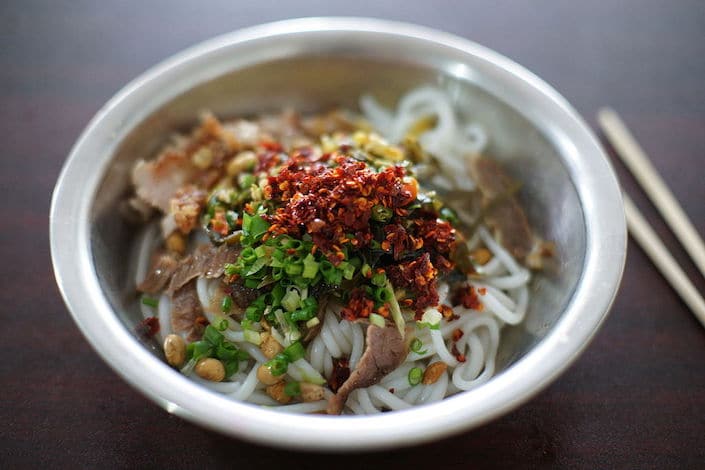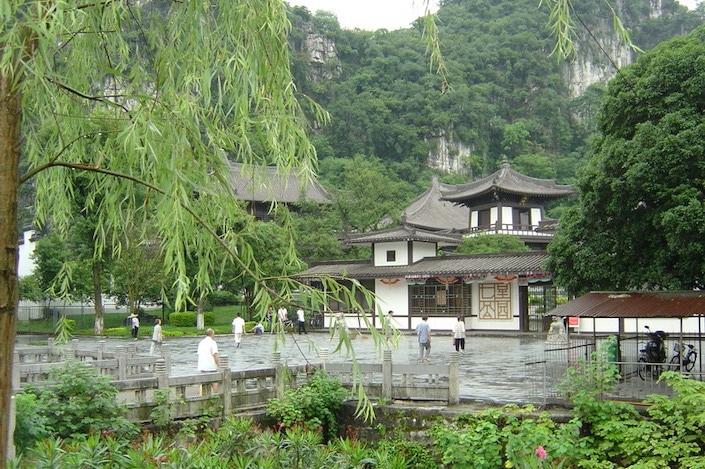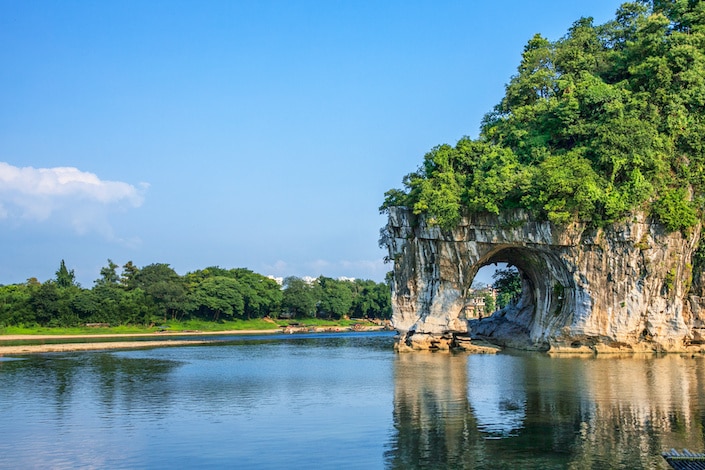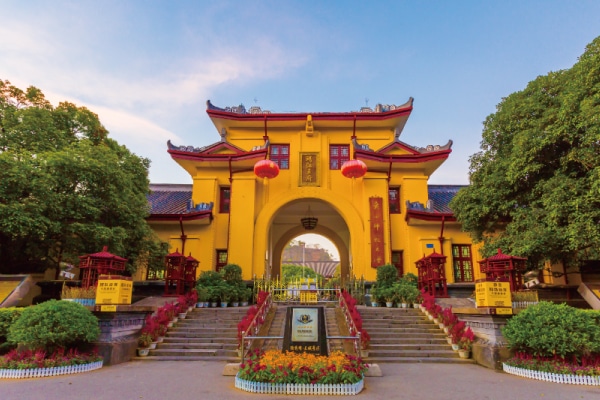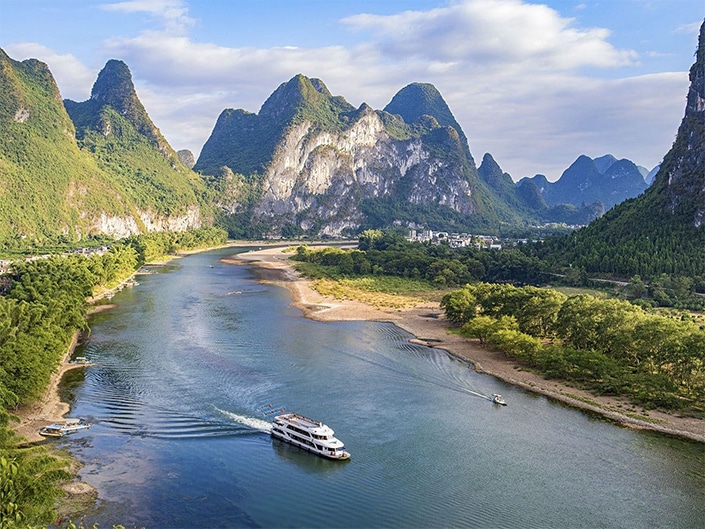A Brief Overview of the History of Guilin: From Ancient Roots to Modern Times
Learn Chinese in China or on Zoom and gain fluency in Chinese!
Join CLI and learn Chinese with your personal team of Mandarin teachers online or in person at the CLI Center in Guilin, China.
Guilin, a city with thousands of years of settlement history, has been a key center for trade and governance in the Guangxi Zhuang Autonomous Region. Its lush valleys and strategic location along Hunan's southern route have established it as an agricultural haven and a trade nexus.
Once a major Buddhist hub, Guilin's enchanting landscape, marked by karst peaks and rice terraces, has captivated artists and writers for generations, deeply influencing Chinese cultural heritage.
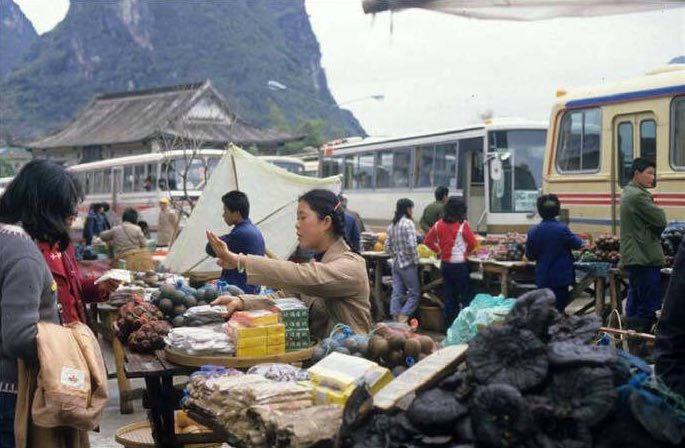
Table of Contents
Early Settlements and Cultural Roots
The roots of Guilin trace back to ancient times, with the earliest known inhabitants being the Zengpiyan people, a matriarchal society that thrived around 10,000 years ago. This period marked the beginning of human settlement in the area, laying the foundational cultural and social practices that would evolve over millennia.
The region was later influenced by the Baiyue people, a collection of non-Han ethnic groups, who settled near the Li River around 314 BCE. These early settlers played a crucial role in shaping the cultural tapestry of Guilin, blending their unique traditions and practices with the natural environment.
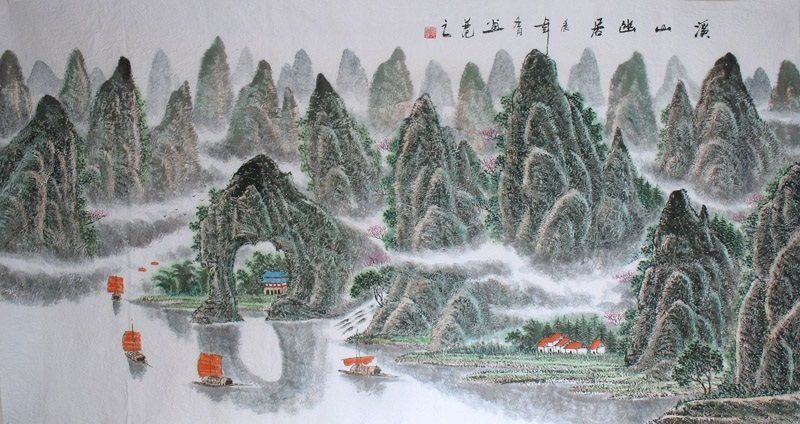
People have lived in the area in and around Guilin for thousands of years.
Guilin Under Changing Names and Dynasties
Throughout its long history, Guilin has been known by various names, each reflecting a different era and cultural influence. Before it was known as 桂林市 (Guìlínshì) in 1940, the city was referred to as 桂林郡 (Guìlínjùn), 桂州 (Guìzhōu), and 桂林府 (Guìlínfǔ).
The name 桂林, meaning “forest of sweet osmanthus,” highlights the city's connection with nature, particularly the osmanthus trees that have been a constant presence in the city's landscape and culture. The changing names over centuries not only denote the city's evolving identity but also its enduring natural beauty and cultural significance.
Guilin as a Center of Trade, Governance, and Buddhism
Guilin's strategic location and fertile valleys have long made it a hub for agriculture, trade, and governance. During the Qin dynasty (221 BCE – 206 BCE), it became a significant administrative center under the first Chinese emperor, marking the beginning of Guilin's importance in regional politics and trade.
Additionally, Guilin emerged as a major Buddhist center, its serene landscape of karst peaks and rice terraces providing an ideal setting for spiritual and artistic inspiration. This period saw Guilin developing into a melting pot of religious, cultural, and economic activities, significantly contributing to its historical and cultural richness.
Ethnic minority peoples encounter the Han
Before the arrival of the Han Chinese, Guangxi and the area that would later become Guilin were home to a variety of different ethnic minority groups (少数民族 shǎoshùmínzú) such as the Zhuang (壮族 Zhuàngzú) and the Yao (瑶族 Yáozú), who were accustomed to independence. With the arrival of the Qin army, they were suddenly subjected to the reign of the emperor.
While the Zhuang were more or less willing to adapt to Han culture and politics, the Yao resisted Chinese acculturation. Areas in central and eastern Guangxi, where the Yao comprised the majority of the population, became a hotbed for unrest.
Ethnic tensions amongst the region’s minority groups and the Han continued to progress throughout the Tang dynasty. Under the Song dynasty, the Zhuang and Yao peoples were treated with an approach alternating between coercion and concession. Unrest continued, and a Zhuang leader even initiated an independent kingdom for a brief stint.
While some ethnic minorities in Guangxi accepted Han rule, others resisted.
Uprisings and violence persisted throughout the Yuan (1206-1368) and Ming (1368-1644) dynasties.
Conflict between ethnic minority groups and Chinese leadership only escalated during the Qing dynasty (清朝 Qīngcháo), which lasted from 1644-1912 CE.
Tensions also increased during the late Qing due to foreign influence in Guangxi. In particular, the signing of the exploitative Treaty of Tianjin in the wake of the Opium Wars and French economic and military activities in parts of Guangxi in the latter half of the 19th century further destabilized the region.
The Taiping Rebellion
During most of the Ming and Qing dynasties, the city that is now called Guilin was the capital of Guangxi Zhuang Autonomous Region.
Guangxi played a pivotal role in Qing dynasty history as the birthplace of the Taiping Rebellion, a bloody civil war that engulfed China from 1850 to 1864 CE. The leader of the Taiping Rebellion, Hong Xiuquan, was a failed imperial exam candidate from Guangdong Province who believed himself to be the younger brother of Jesus.
Guangxi origins
In the early 1840’s, Hong and a distant cousin named Feng Yunshan converted to Christianity and began to travel around southern China seeking converts. Hong had some distant relatives in Guiping County, Guangxi, so the two traveled there in 1844 to preach.
They were successful at gaining many new followers in the Thistle Mountain region of Guangxi. Soon, they began referring to their group of new converts as the God-worshipping Society.
In 1850, Qing imperial troops moved through Guangxi on their way to put down a rebellion that was brewing there as a result of a famine. Some of these troops threatened to kill some of the God-worshipping Society members that they met, prompting Hong and Feng to lead their society in a revolt against the Qing.
In January 1851, Hong announced the creation of the Taiping Heavenly Kingdom and armed clashes between Qing troops and the God Worshipers began. This incident, called the Jintian Uprising, marked the beginning of the Taiping Rebellion.
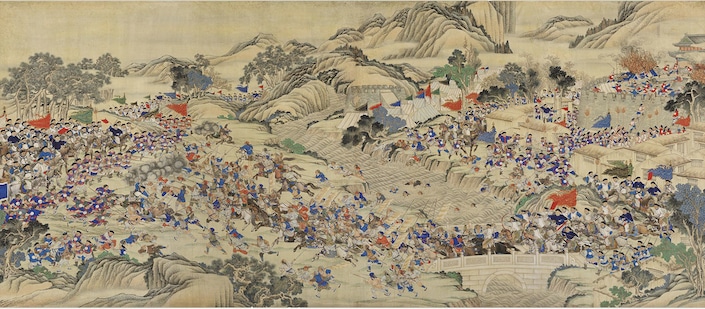
Guangxi Province, of which Guilin was the capital during the era portrayed above, played a pivotal role as the birthplace of the Taiping Rebellion.
Siege of Guilin and aftermath
After achieving victory at Jintian, the rebels moved on, capturing another Guangxi city called Yongan in fall 1851. After being attacked by Qing forces, the Taiping rebels left Yongan and marched to Guilin.
In 1952, the 40,000 strong Taiping force laid siege to Guilin for 33 days. The Taipings met with fierce resistance, however. Despite their use of siege towers, rockets and ladders, they were defeated by General Jiang Zhongyuan and forced to give up without taking the city.
They then marched towards Hunan, only to be ambushed at Suoyi Ford, where around 10,000 Taipings, many originally from Guangxi, were killed. The ambush threatened to wipe out their movement, but they continued on to Hunan, where they picked up many new followers.
The Taipings captured the ancient city of Nanjing in 1853, making it their capital. Their movement would continue for over 10 years after that, until their ultimate defeat by Qing forces in 1864.
Modern Guilin History
At the dawn of the 20th century, Guilin experienced a transformative shift, losing its status as the capital of Guangxi to Nanning.
This significant change marked the beginning of a new era in Guilin's history, reshaping its role and stature within the region, yet it continued to play a vital role in the political landscape, serving as a strategic base for the Nationalist Party under the leaderships of Sun Yat-sen and Chiang Kai-shek.
Shift of Capital and Political Changes
In the early 1900s, a significant shift occurred when Guilin, the longstanding capital of Guangxi, was replaced by Nanning (南宁市 Nánníngshì) as the provincial capital. This transition marked a new chapter in Guilin's history, altering its role and influence in the region.
Despite this change, Guilin remained a pivotal political player. It served as a key stronghold for the Nationalist Party (Guomindang), first under the leadership of Sun Yat-sen and later, Chiang Kai-shek. During this tumultuous period, from 1906 to 1916, Guilin witnessed and contributed to the foundational efforts of the emerging republic led by Sun Yat-sen.
The Era of Chiang Kai-shek and the Guangxi Clique
Chiang Kai-shek's ascension to power in 1927 brought new dynamics to Guilin's political landscape. Struggling to establish a strong central government, Chiang faced challenges in unifying various factions across the country.
In this context, a powerful group of local leaders, known as the Guangxi Clique, played a crucial role. They governed the region with a degree of autonomy, navigating the complexities of national politics while maintaining Guilin's strategic importance. This period was marked by political maneuvering and regional assertion, further shaping Guilin's historical trajectory.
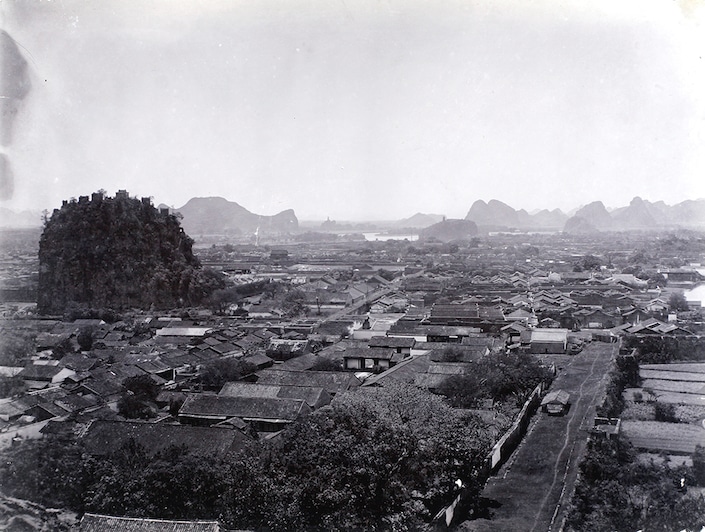
Guangxi was a hotbed of revolutionaries during the 20th century. Image copyright SOAS (The School of Oriental and African Studies) Archives, courtesy of the Reginald Hedgeland collection and Historical Photographs of China, University of Bristol (www.hpcbristol.net).
Guilin in the Communist Movement
The late 1920s and early 1930s saw members of the Zhuang minority group in Guilin joining the growing communist movement, reflecting the shifting political tides in the region. Amidst these changes and uncertainties, Guilin continued to hold its strategic significance.
The year 1940 was a landmark moment when the city was officially named Guilin (桂林市 Guìlínshì), a designation that has persisted to this day. This era underscored Guilin's resilience and adaptability, maintaining its relevance and importance despite the sweeping political transformations occurring in China.
Guilin During Wartime
World War II
In 1937, war broke out between China and Japan. The Japanese had already invaded northeastern China, which they occupied starting in 1932.
China was among the Allied Powers in World War Two, along with Great Britain, the Soviet Union and the United States.
During the war, the city of Guilin became the primary base for the Chinese and Allied air forces. There was even a squadron of volunteer American air force personnel based in Guilin known as the Flying Tigers.
In 1939, the Japanese invaded and occupied Nanning and Longzhou. In 1944, Japanese forces made a coordinated effort to conquer Guangxi. After winning the Battle of Guilin-Liuzhou, they briefly captured Guilin, Liuzhou, and Wuzhou, but Chinese troops soon took back the city.
The city of Guilin played a crucial role throughout the China theatre of World War Two, known in China as the War of Resistance Against Japanese Aggression (抗日战争 Kàngrì Zhànzhēng), as the site of an air base where Chinese soldiers launched many defensive attacks against Japanese troops.
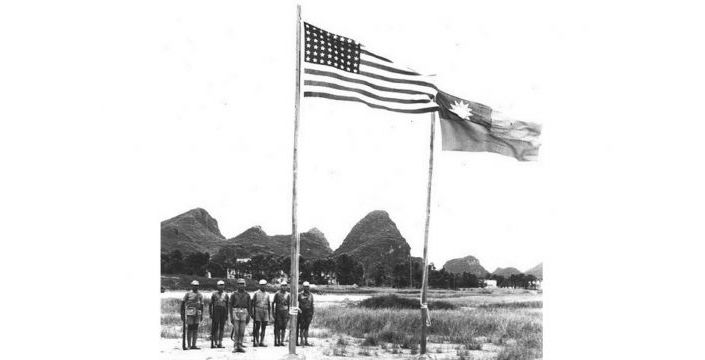
During World War II, a squadron of volunteer American air force personnel was based in Guilin.
Civil War
After the China theatre of World War Two concluded in 1945, Guilin residents only enjoyed a brief respite from violence. A civil war soon broke out between Chiang’s Nationalist Party (国民党 Guómíndǎng) and Mao Zedong’s Communist Party (共产党 Gòngchǎndǎng).
Communist forces took Guilin in 1949, making Guangxi part of the People’s Republic of China (PRC). Also in 1949, the Communist forces defeated the Nationalists in the civil war that had been ongoing throughout the country. China started a new phase of governance led by Mao Zedong and the Communist Party, which still leads the country today.
In 1958, Guangxi was reclassified as an autonomous region. It is now known as Guangxi Zhuang Autonomous Region (广西壮族自治区 Guǎngxī Zhuàngzú Zìzhìqū).
How historical legacies shape Guilin today
A diverse population
The population of the area in and around where modern Guilin is situated has always been diverse. This was true in the days of the Bai Yue, and it remains true to this day.
As the name Guangxi Zhuang Autonomous Region suggests, the ethnic group with the most members currently living in Guangxi is the Zhuang. Today, the Zhuang are the largest of China’s 55 non-Han ethnic minority groups. There are around 18 million Zhuang people in China, and most of them live in Guangxi. In fact, the Zuang make up around 32% of Guangxi’s population.
Other ethnic groups in Guangxi and Guilin include the Yao, the Dong, the Miao, the Hui, the Yi, the Shui and the Gin.
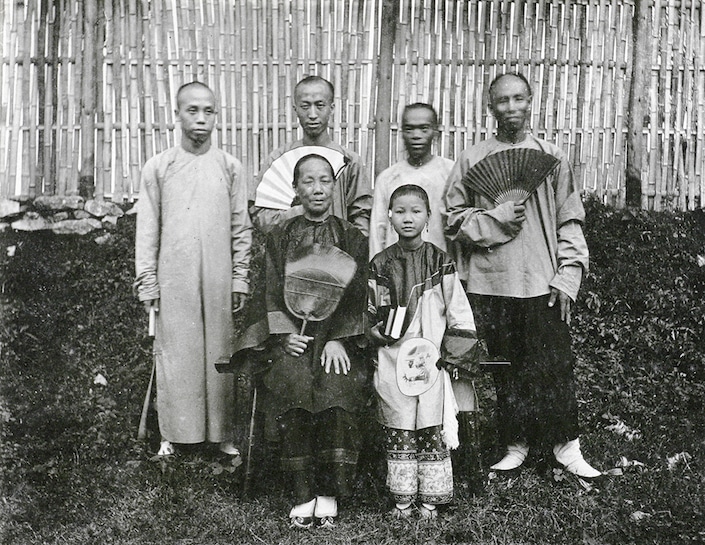
Guilin’s population has always been diverse. Image copyright Peter Lockhart Smith, courtesy of the Banister Family and Historical Photographs of China, University of Bristol (www.hpcbristol.net).
Protected status
The early 1980s was a time of significant reform in the People’s Republic of China. Amongst many other legal and political actions intended to modernize China, the government took proactive steps to preserve the geographic and cultural integrity of certain regions.
In 1981, the State Council designated Guilin a culturally and historically protected city. At the time, only three other Chinese cities were also granted this protected status: Beijing, Hangzhou, and Suzhou.
Local officials were tasked with preserving not only Guilin’s natural scenery, but also its cultural heritage (文化遗产 wénhuàyíchǎn). In 2014, the unique Guilin karst landscape became a UNESCO World Heritage site.
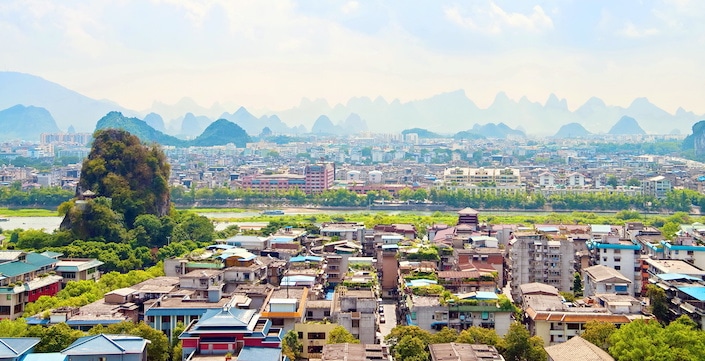
Starting in the 1980’s, the Chinese government has taken steps to protect Guilin’s landscape and culture.
Guilin: Welcoming visitors from China and abroad
To this day, Guilin is a vital city in Guangxi and in China more broadly. Both Guilin and Yangshuo are still nationally-recognized scenic areas and Guilin’s beauty is appreciated by locals as well as by visitors from around the world.
Today, Guilin is a relatively small Chinese city with a population of approximately 1,154,700, making it an ideal place to learn Chinese.
The city provides an immersive experience, and its scenery and culture will amaze anyone who has the opportunity to visit. Consider studying Mandarin at CLI, located in the bustling and beautiful city of Guilin!
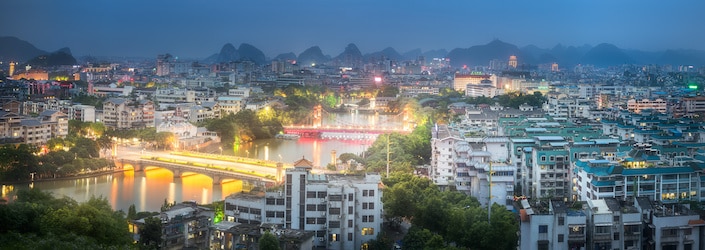
Today, Guilin is a bustling, modern city renowned for the beauty of the karst mountains that surround it.
Guilin History Vocabulary
| Hànzì | Pīnyīn | Definition |
|---|---|---|
| 桂林市 | Guìlínshì | Guilin city |
| 桂 | guì | osmanthus |
| 广西壮族自治区 | Guǎngxī Zhuàngzú Zìzhìqū | Guangxi Zhuang Autonomous Region |
| 南宁市 | Nánníngshì | Nanning city |
| 历史 | lìshǐ | history |
| 少数民族 | shǎoshùmínzú | ethnic minority |
| 壮族 | Zhuàngzú | the Zhuang people (a Chinese ethnic group) |
| 瑶族 | Yáozú | the Yao people (a Chinese ethnic group) |
| 朝代 | cháodài | dynasty |
| 清朝 | Qīngcháo | Qing dynasty |
| 抗日战争 | Kàngrì Zhànzhēng | War of Resistance Against Japanese Aggression |
| 国民党 | Guómíndǎng | Nationalist Party |
| 共产党 | Gòngchǎndǎng | Communist Party |
| 国共内战 | Guó Gòng Nèizhàn | Chinese Civil War |
| 景色 | jǐngsè | scenery |
| 旅游 | lǚyóu | tourism |
| 文化遗产 | wénhuàyíchǎn | cultural heritage |






